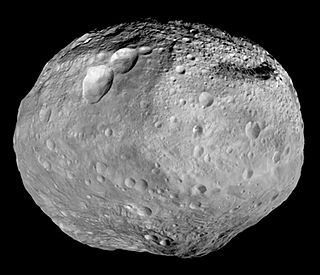
A protoplanet is a large planetary embryo that originated within a protoplanetary disk and has undergone internal melting to produce a differentiated interior. Protoplanets are thought to form out of kilometer-sized planetesimals that gravitationally perturb each other's orbits and collide, gradually coalescing into the dominant planets.
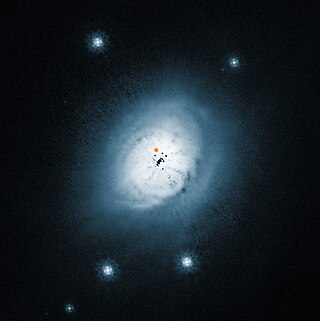
HD 100546, also known as KR Muscae, is a pre-main sequence star of spectral type B8 to A0 located 353 light-years from Earth in the southern constellation of Musca. The star is surrounded by a circumstellar disk from a distance of 0.2 to 4 AU, and again from 13 AU out to a few hundred AU, with evidence for a protoplanet forming at a distance of around 47 AU.

HD 37974 a variable B[e] hypergiant in the Large Magellanic Cloud. It is surrounded by an unexpected dust disk.

Zeta Chamaeleontis, Latinized from ζ Chamaeleontis, is a star located in the constellation Chamaeleon. Located around 540 light-years distant, it shines with a luminosity approximately 522 times that of the Sun and has a surface temperature of 15,655 K.

ι Chamaeleontis, Latinized as Iota Chamaeleontis, is a single star in the southern circumpolar constellation of Chamaeleon. It is visible to the naked eye as a dim, yellow-white hued point of light, having an apparent magnitude of about 5.3. Based upon parallax measurements, this star is around 188 light years away from the Sun, but it is drifting closer with a radial velocity of −4 km/s.
Lambda Chamaeleontis, Latinized from λ Chamaeleontis, is a star located in the constellation Musca. Lambda Chamaeleontis is also known as HR 4617, and HD 105340. This star is visible to the naked eye as a dim, orange-hued star with an apparent visual magnitude of 5.165. It is located 472 light-years from the Sun, based on its parallax, but is drifting closer with a radial velocity of −45 km/s.
Mu2 Chamaeleontis (μ2 Cha) is a star located in the constellation Chamaeleon. It is not bright enough to be readily visible to the naked eye, having an apparent visual magnitude of 6.60, but has an absolute magnitude of 0.59. The distance to this object is approximately 556 light years, based on the star's parallax. The star's radial velocity is poorly constrained, but it appears to be drifting further away at the rate of around +3 km/s.

HD 142527 is a binary star system in the constellation of Lupus. The primary star belongs to the Herbig Ae/Be star class, while the companion, discovered in 2012, is a red dwarf star or accreting protoplanet with a projected separation of less than 0.1″. The system is notable for its circumbinary protoplanetary disk and its discovery has helped refine models of planet formation. The orbit of companion is strongly inclined to the circumbinary protoplanetary disk.

HD 259431 is a young stellar object in the constellation of Monoceros.

HD 87643 is a B[e] class binary star embedded in a reflection nebula.

DI Chamaeleontis, also known as Hen 3-593 or HIP 54365, is a quadruple star system in the constellation Chamaeleon. The system is roughly 700 light years from Earth.
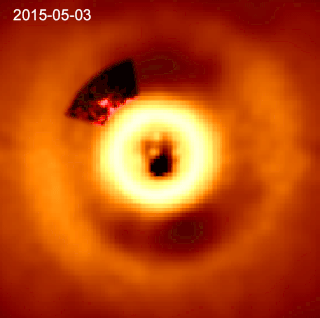
HD 169142 is a single Herbig Ae/Be star. Its surface temperature is 7650±150 K. HD 169142 is depleted of heavy elements compared to the Sun, with a metallicity Fe/H index of −0.375±0.125, but is much younger at an age of 7.5±4.5 million years. The star is rotating slowly and has relatively low stellar activity for a Herbig Ae/Be star.

A circumplanetary disk is a torus, pancake or ring-shaped accumulation of matter composed of gas, dust, planetesimals, asteroids or collision fragments in orbit around a planet. They are reservoirs of material out of which moons may form. Such a disk can manifest itself in various ways.

HD 111395 is a single, variable star in the northern constellation of Coma Berenices. It has the variable star designation LW Com, short for LW Comae Berenices; HD 111395 is the Henry Draper Catalogue designation. The star has a yellow hue and is just bright enough to be barely visible to the naked eye with an apparent visual magnitude that fluctuates around 6.29. Based upon parallax measurements, it is located at a distance of 55.8 light years from the Sun. The star is drifting closer with a radial velocity of −8.9 km/s. It is a member of the Eta Chamaeleontis stellar kinematic group.

HD 150193 is a binary star system in the constellation of Ophiuchus. The primary star was identified as a Herbig Ae/Be star with a strong solar wind, losing approximately a tenth of solar mass per million years. It does host a very small debris disk, likely due to disk truncation by the nearby stellar companion. The disk is inclined 38±9° to the plane of sky. It appears to be highly evolved and asymmetric, with indications of flattening and grains growth.
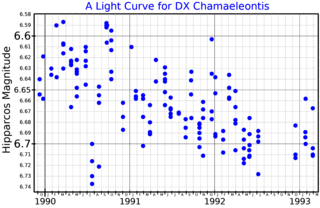
HD 104237 is a candidate multiple star system in the southern constellation of Chamaeleon. It has the variable star designation DX Chamaeleontis, abbreviated DX Cha; HD 104237 is the stellar designation from the Henry Draper Catalogue. The system is dimly visible to the naked eye with an apparent visual magnitude that ranges from 6.59 down to 6.70. It is located at a distance of approximately 348 light-years from the Sun based on parallax measurements. The system is positioned just 2′ to the north-east of the 5th magnitude star Epsilon Chamaeleontis, and is a member of the ε Cha association of co-moving stars.
HD 100453 is a binary star system which lies in the constellation Centaurus about 350 light years away from the Sun and is a member of the open cluster Scorpius–Centaurus association.
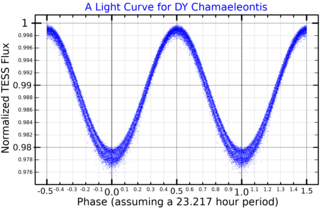
HD 118285, also known as HR 5115, is a variable star located in the southern circumpolar constellation Chamaeleon. DY Chamaeleontis is its variable star designation. It has an average apparent magnitude of 6.32, placing it near the limit for naked eye visibility. The object is located relatively far at a distance of 864 light years based on Gaia DR3 parallax measurements but is receding with a heliocentric radial velocity of 18 km/s. At its current distance, HD 118285's brightness is diminished by 0.58 magnitudes due to interstellar dust.

HD 93486, also known as HIP 52381, is a binary star located in the southern circumpolar constellation Chamaeleon near the border with Octans. Its variable star designation is RZ Chamaeleontis. It has an apparent magnitude ranging from 8.2 to 9.1, which is below the limit for naked eye visibility. Gaia DR3 parallax measurements place the system 568 light years away, and it is currently receding with a heliocentric radial velocity of 20 km/s. At its current distance, HD 93486's average brightness is diminished by 0.53 magnitudes due to interstellar dust. The system has a combined absolute magnitude of +1.72.

R Chamaeleontis, also known as HD 71793, is a Mira variable located in the southern circumpolar constellation Chamaeleon. It has an apparent magnitude that ranges from 7.5 to 14.1, which is below the limit for naked eye visibility. Gaia DR3 parallax measurements place it about 3,000 light years away and it is currently approaching with a heliocentric radial velocity of 22 km/s.

















